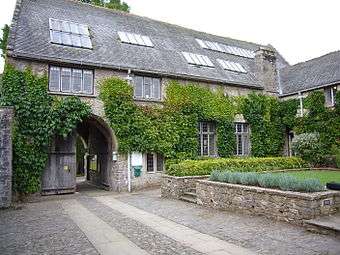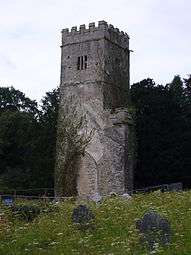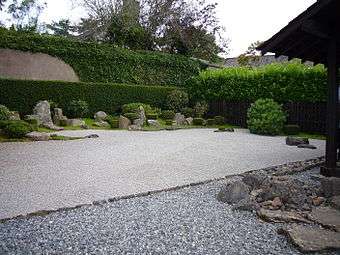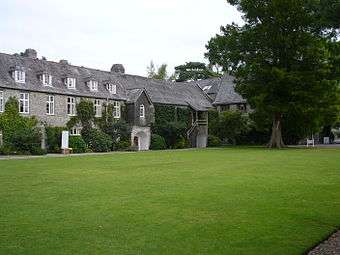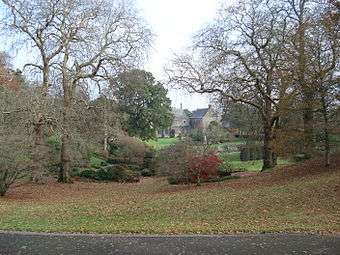Dartington Hall
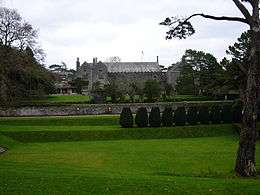
Dartington Hall in Dartington, near Totnes, Devon, England, is a country estate that is the headquarters of the Dartington Hall Trust, a charity specialising in the arts, social justice and sustainability.
The Trust currently runs 16 charitable programmes, including Schumacher College and the Dartington International Summer School. In addition to developing and promoting arts and educational programmes, the Trust hosts other groups and acts as a venue for retreats.
The hall itself is a Grade I listed building. The gardens are Grade II* listed in the National Register of Historic Parks and Gardens.[1]
Dartington Hall estate

The Dartington Hall Trust is based on a 1,200 acres (4.9 km2) estate near Dartington in south Devon. The medieval hall was built between 1388 and 1400 for John Holand, Earl of Huntingdon, half-brother to Richard II. After John was beheaded, the Crown owned the estate until it was acquired in 1559 by Sir Arthur Champernowne, Vice-Admiral of the West under Elizabeth I. The Champernowne family then lived in the Hall for 366 years until 1925.
The hall was mostly derelict by the time it was bought by Leonard and Dorothy Elmhirst in 1925. They commissioned architect William Weir to renovate the buildings and restored the Great Hall's hammerbeam roof.[2] Inspired by a long association with Rabindranath Tagore's Shantiniketan, where Tagore was trying to introduce progressive education and rural reconstruction into a tribal community, they set out on a similar goal for the depressed agricultural economy in rural England.[3] In 1935, the Dartington Hall Trust, a registered charity, was set up in order to run the estate.
The estate comprises various schools, colleges and charitable and commercial organisations, including Schumacher College, the Arts at Dartington, the Dartington International Summer School of music, Research in Practice, Dartington School for Social Entrepreneurs and the Shops at Dartington (formerly the Cider Press Centre). In North Devon, the Beaford Centre, set up as an arts centre by the Trust in the 1960s to bring employment and culture to a rurally depressed area, continues to thrive. Until June 2010, prior to the college's contentious merger with University College Falmouth, the estate was also home to Dartington College of Arts.[4][5]
The Hall and medieval courtyard functions in part as a conference centre and wedding venue and provides bed and breakfast accommodation for people attending courses and for casual visitors. The Barn Cinema and the White Hart Bar and Restaurant are used by estate dwellers, residents from the surrounding countryside, and visitors alike.
In May 2010, Sotheby's sold a group of 12 paintings by Rabindranath Tagore, which had been given by Tagore to his friend Leonard Elmhirst.[6] In Autumn 2011, The Trust proposed the sale of additional artworks by Ben Nicholson, Christopher Wood, Alfred Wallis and others, again at Sotheby's.[7] The sale generated some criticism from local people,[8] who voiced concerns about deaccessioning of the Trust's art assets. The Trust argued that the founders went to considerable lengths to make clear that art works and other assets could and should be used and sold at the discretion of the Trustees to support the activities of the Trust.[9]
"Dartington Hall held by the MARTIN FAMILY between the early 12th and mid 14th centuries and on the death of Lord William Martin in 1326, the Barony of Martin fell in abeyance..", wrote Anthony Emery.[10]
See also
- D. G. Champernowne, the mathematician and economist, is buried in the church yard.
Dartington International Summer School
Dartington International Summer School is a department of The Dartington Hall Trust. The Summer School is both a festival and a music school. Participants, both amateur musicians and advanced students, spend the daytime studying a variety of different musical courses, and the evenings attending (or performing in) concerts. In addition to instrumental and vocal masterclasses, there are courses at various levels on subjects such as composition, opera, chamber music, conducting and improvisation. Courses include choirs, orchestras, individual masterclasses, and non classical music such as Jazz, Salsa and Gamelan. Composition teachers have included Luciano Berio, Luigi Nono, Bruno Maderna, Harrison Birtwistle, Peter Maxwell Davies, Brian Ferneyhough, Witold Lutosławski and Elliott Carter.
Dartington Gardens
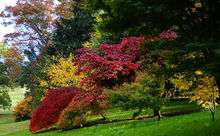
The gardens were created by Dorothy Elmhirst with the involvement of major landscape designers Beatrix Farrand and Percy Cane and feature a tiltyard (thought actually to be the remains of an Elizabethan water garden) and major sculptures, including examples by Henry Moore, Willi Soukop and Peter Randall-Page. There is an ancient yew tree (Taxus baccata) reputed to be nearly 2000 years old and rumour has it that Knights Templar are buried in the graveyard there, although there is no evidence to substantiate this.
Former activities
Dartington Hall School
Dartington Hall School, founded in 1926, offered a progressive coeducational boarding life. When it started there was a minimum of formal classroom activity and the children learnt by involvement in estate activities. It was to have “no corporal punishment, indeed no punishment at all; no prefects; no uniforms; no Officers’ Training Corps; no segregation of the sexes; no compulsory games, compulsory religion or compulsory anything else, no more Latin, no more Greek; no competition; no jingoism.”[11]
With time more academic rigour was imposed, but it remained progressive and had mixed success educating the children, sometimes the more wayward ones, of the fee-paying parents. A noted alumnus was Lord Young, a founder of Which? and the Open University. Lucian Freud attended the school for two years and his brother Clement Freud was also a pupil there.[12] Other noted alumni include Oliver Postgate,[13] Martin Bernal, Max Fordham, Ivan Moffat, Eva Ibbotson, Matthew Huxley, Richard Leacock, Lionel Grigson, 1970s pop music act Marshall Hain, and the sculptor Sokari Douglas Camp.
W. B. Curry was headmaster of the school from 1931 to 1957, and wrote two books about it, The School, published by The Bodley Head in 1934, and Education for Sanity, published by Heinemann in 1947.[14]
The author Dennis Wheatley novelised the activities of some people based at the school in his 1947 book "The Haunting of Toby Jugg". This was a supernatural thriller which sensationalised some real-life events before the war, setting them at a fictional school called "Weylands". Years later, it was revealed that these events had attracted the attention of MI5 in a recently declassified report called The Case Against Dartington Hall[15]
At its peak, the school had some 300 pupils. However, with the advent of state-based progressive education, the death of its founders, and the appointment of a new headmaster who was at odds with the school's philosophies and subsequently generated a significant amount of negative publicity, the school suffered a dramatic drop in recruitment. Despite the efforts of those who cared about the school, it finally shut its doors in 1987. After the school's closure a number of staff and students set up Sands School which still carries some of the principles that Dartington once had.
Literary editor Miriam Gross wrote an account of her time at the school for the May 2011 edition of Standpoint magazine.[16]
Dartington College of Arts
Dartington College of Arts was a specialist arts institution based at the hall from 1961 to 2008, with an international reputation for excellence, focusing mainly on the performance arts. In 2008, it became part of University College Falmouth and subsequently relocated to Falmouth, Cornwall.
Gallery
References
- ↑ Historic England. "Dartington Hall (1000453)". National Heritage List for England. Retrieved 12 February 2016.
- ↑ Snell, Reginald (1986). William Weir and Dartington Hall. Dartington Hall Trust. ISBN 0-902386-10-7.
- ↑ Sen, Amartya (28 August 2001). "Tagore and His India". Nobelprize.org. Archived from the original on 9 October 2011. Retrieved 25 October 2011.
- ↑ Steven Morris (28 December 2006). "Battle to save celebrated cradle of cutting edge art". The Guardian. Retrieved 5 February 2011.
- ↑ Anthea Lipsett (10 March 2008). "Last-ditch attempt to halt Dartington merger". Education Guardian. The Guardian. Retrieved 5 February 2011.
- ↑ Sotheby's to Sell Tagore Collection of The Dartington Hall Trust, artdaily.org. Retrieved 12 October 2011.
- ↑ Sotheby's unveils a group of Modern British art from the Dartington Hall Trust Collection, artdaily.org. Retrieved 16 November 2011.
- ↑ Row as Dartington Hall auctions off its treasures guardian.co.uk. Retrieved 16 November 2011.
- ↑ On the sale of works of art from the collection dartington.org
- ↑ http://archaeologydataservice.ac.uk/catalogue/adsdata/arch-1132-1/dissemination/pdf/115/115_184_202.pdf
- ↑ Young, Michael (1982), The Elmhirsts of Dartington, Routledge and Kegan Paul, p. 131
- ↑ "Sir Clement Freud". telegraph.co.uk. London. 16 April 2009. Retrieved 23 December 2009.
- ↑ "Oliver Postgate: Creator of 'Bagpuss', 'The Clangers' and 'Ivor the Engine' who turned children's television into an art form". The Independent. London. 10 December 2008. Retrieved 1 May 2010.
- ↑ Gribble, David (ed.), That’s All, Folks, Dartington Hall School Remembered; reminiscences and reflections of former pupils, West Aish Publishing, 1987. ISBN 0951273507
- ↑ http://www.denniswheatley.info/convention2014.html/ Dartington Hall report at the end
- ↑ Gross, Miriam (May 2011). "An Experimental Education". Standpoint. Retrieved 25 October 2011.
Further reading
- Anonymous, Dartington, Webb & Bower, 1982.
- Bonham-Carter, Victor (1970) [1958]. Dartington Hall: the Formative Years 1925-1957. Dulverton (Somerset): Exmoor Press. ISBN 0-9500133-9-0.
- Wheatley, Dennis. The Haunting of Toby Jugg (1947). Critical novel, based on life at the school.
- Punch, Maurice (1977). Progressive Retreat: a Sociological Study of Dartington Hall School, 1926-1957, and Some of its Former Pupils. London: Cambridge University Press. ISBN 0-521-21182-4.
- Young, Michael (1982). The Elmhirsts of Dartington: the Creation of an Utopian Community. London: Routledge & Kegan Paul. ISBN 0-07-100905-1.
External links
| Wikimedia Commons has media related to Dartington Hall. |
- The Dartington Hall Trust
- Dartington Hall
- The Arts at Dartington
- Dartington International Summer School
- Dartington Hall School alumni website
- Charity Commission. The Dartington Hall Trust, registered charity no. 279756.
Coordinates: 50°27′06″N 3°41′38″W / 50.4518°N 3.6938°W

